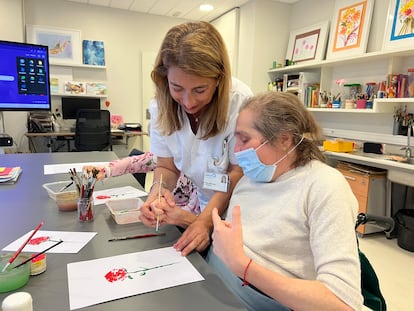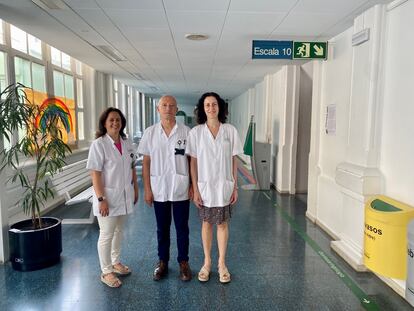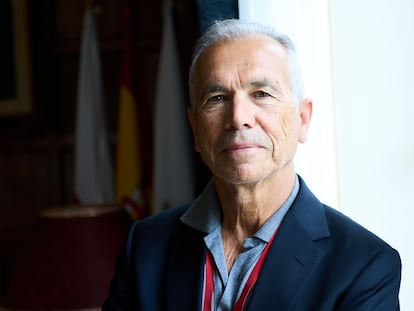A genetic variant sheds light on the enigma of multiple sclerosis: Why do some patients need a wheelchair while others can climb the Everest?
A recent discovery opens a new avenue to seek treatments against the disease, initiated by the kissing disease virus

A study of 10 million military personnel revealed last year that the ubiquitous Epstein-Barr virus, which infects 94% of people and causes mononucleosis (also known as the kissing disease) is also the leading cause of multiple sclerosis (MS), a rare disorder that, in the most severe cases, causes trouble speaking and walking. In 36 out of every 100,000 people, the virus triggers a process in which the human body’s own immune system destroys the protective covering of the nerve fibers, as if the cables of the brain and spinal cord were being peeled. Some patients require a wheelchair, but others are able to reach the summit of Everest, like the American teacher Lori Schneider. Now, a new study with 22,000 patients has identified the first genetic variant associated with a more aggressive evolution of the disease. The researchers believe that this discovery opens a new path toward treatments that prevent disability.
The authors, from two international consortia with a total of about 150 scientists, examined seven million genetic variants until they identified a key region between two genes: DYSF, which is involved in the repair of damaged cells in muscles, and ZNF638, which is involved in the control of virus infections. Neurologist Sara Llufriu, from the Hospital Clínic in Barcelona, explains that if a person inherits this variant from both their mother and their father, “they will need to use a cane more than three and a half years earlier.” The Hospital Clínic contributed the data of some 300 patients to the macro-study, which was published this Wednesday in the journal Nature.
The scientific community had already found some 200 genetic variants associated with the risk of multiple sclerosis, but this is the first to be linked to the rapid progression of the disease, according to neurologist Manuel Comabella from the Multiple Sclerosis Center of Catalonia. “The disease is very heterogeneous. Many patients first need a crutch to walk, then two crutches, and finally become wheelchair dependent. But there are also more benign forms. There are patients who are even very physically active and run miles and miles. This must be due to possibly genetic factors,” explains Comabella. His center, part of the Vall d’Hebron Hospital in Barcelona, provided information on 173 patients.
There is no cure for multiple sclerosis, but in recent decades there has been a “therapeutic revolution” that has made it possible to reduce and even prevent outbreaks of the disease, according to the authors of the new study. The disorder is characterized by an inflammatory process, which is key at the beginning, and a neurodegenerative component that is responsible for the progression of the disease. Current treatments only act on the inflammation, so they do not stop the progression of multiple sclerosis in the long term. Comabella explains that the discovery of the genetic variant points to a new Achilles heel. “The finding shines a light on a possible mechanism involved in the progression of the disease, which in the future could be susceptible to being blocked with drugs,” says the neurologist.

The data from the 22,000 patients also suggest that a person’s level of education plays a protective role against multiple sclerosis, while smoking aggravates the disease. British neurologist Stephen Sawcer, from the University of Cambridge, one of the lead authors of the study, admits that these effects are difficult to quantify: “We have seen that, on average, each extra year of study reduces severity by about 0.05 points, on a scale of 0 to 10, which is equivalent to 0.5%,” he says. The level of education also plays a protective role in other neurodegenerative diseases, such as Alzheimer’s.
The investigation includes patient data from Europe, Australia, the United States and Canada. Neurologist Luis Querol, from the Hospital de la Santa Creu i Sant Pau in Barcelona, emphasizes the limitations of the study, in which he did not participate. “There are many factors involved in the rapid progression to disability: the age of patients, habits, treatments used, even geographical variants,” Querol explained to the Science Media Center website. “Some of these factors do not seem to have been taken into account, so new cohorts would be needed to control for these differences to see if the results are replicated.”
The team led by Italian epidemiologist Alberto Ascherio from Harvard University discovered last year that the Epstein-Barr virus, which causes the kissing disease, is also “the main cause” of MS. “Multiple sclerosis probably doesn’t develop if a person is not infected with the virus,” he explained in an interview with EL PAÍS. For Ascherio, the disease is “a rare complication of an Epstein-Barr virus infection.” The new study will serve to shed some light on what happens once this complex autoimmune-inflammatory process begins.
Sign up for our weekly newsletter to get more English-language news coverage from EL PAÍS USA Edition
Tu suscripción se está usando en otro dispositivo
¿Quieres añadir otro usuario a tu suscripción?
Si continúas leyendo en este dispositivo, no se podrá leer en el otro.
FlechaTu suscripción se está usando en otro dispositivo y solo puedes acceder a EL PAÍS desde un dispositivo a la vez.
Si quieres compartir tu cuenta, cambia tu suscripción a la modalidad Premium, así podrás añadir otro usuario. Cada uno accederá con su propia cuenta de email, lo que os permitirá personalizar vuestra experiencia en EL PAÍS.
¿Tienes una suscripción de empresa? Accede aquí para contratar más cuentas.
En el caso de no saber quién está usando tu cuenta, te recomendamos cambiar tu contraseña aquí.
Si decides continuar compartiendo tu cuenta, este mensaje se mostrará en tu dispositivo y en el de la otra persona que está usando tu cuenta de forma indefinida, afectando a tu experiencia de lectura. Puedes consultar aquí los términos y condiciones de la suscripción digital.
More information
Últimas noticias
The murder of Michele and Rob Reiner: A tale of horrific days in Hollywood
Trump orders a ‘complete blockade of sanctioned oil tankers’ going to and from Venezuela
Not all insomnia is the same: Study identifies five subtypes and paves the way for personalized treatment
The United States designates Clan del Golfo as a foreign terrorist group
Most viewed
- ‘El Limones’ and the growing union disguise of Mexican organized crime
- Christian Louboutin: ‘Young people don’t want to be like their parents. And if their parents wear sneakers, they’re going to look for something else’
- ‘We are dying’: Cuba sinks into a health crisis amid medicine shortages and misdiagnosis
- A mountaineer, accused of manslaughter for the death of his partner during a climb: He silenced his phone and refused a helicopter rescue
- The low-cost creative revolution: How technology is making art accessible to everyone











































